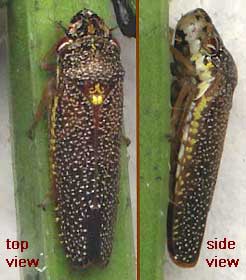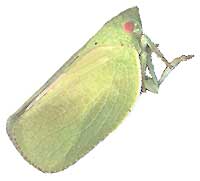 English Name: Leafhopper
English Name: LeafhopperFamily: Cicadellidae
Genus: ?
Species: ?
 English Name: Leafhopper
English Name: Leafhopper
Family: Cicadellidae
Genus: ?
Species: ?
Many kinds of leafhoppers exist and some of them are very pretty, though small, and often going unnoticed. I wouldn't have spotted the one shown at the right one morning if I had not been preparing breakfast over my campfire when I noticed little droplets of water squirting from a certain spot on a vervain stem, about one droplet every two seconds. When I put my nose up to the stem I saw the leafhopper in the picture. He was about 3/8-inch long (10 mm). Leafhoppers suck sap from plants. Since they must suck very much sap to get the nutrients they need, they constantly issue excess liquid from their anuses. This liquid is called honeydew and is described in more detail below. This was one of the most accommodating insects I've ever encountered. I cut the vervain stem, brought the stem section with him on it into the house and scanned the pictures you see above -- and he never moved! Later, with my fingers I lifted him from the stem, put him on another vervain stem, and when I went back half an hour later he once again had his strawlike proboscis inserted into the vervain stem and was squirting out his honeydew as fast as ever.
 English Name: Flatid Planthopper
English Name: Flatid Planthopper
Family: Flatidae
Genus: ?
Species: ?
The little critter at the right in only about 7/16ths of an inch long (1 cm). Often Flatid Planthoppers are found in small groups, one above the other in a line along a stem. Hundreds of Flatid Planthopper species exist and it's hard for backyard naturalists to identify their discoveries even to the genus level. If you ever sit beneath a plant on which Flatid Planthoppers are feeding, you'll soon discover yourself taking a slow-motion shower. The planthoppers above you will be sucking large volumes of plant sap from the stem they're on, and in a sense they'll be peeing on you! In fact, in most Homopterans a portion of the digestive system is modified into a filter chamber that separates out the most substantial particles in the sap for digestion, while excess water, sugars, and certain amino acids are excreted as honeydew. Many species of ants provide care and protection for certain homopterans in exchange for the honor of harvesting the energy-rich honeydew they excrete. Notice the veins on the above planthopper's green wings, which help the insect look like a bud or leaf, and thus contributes to its camouflage.